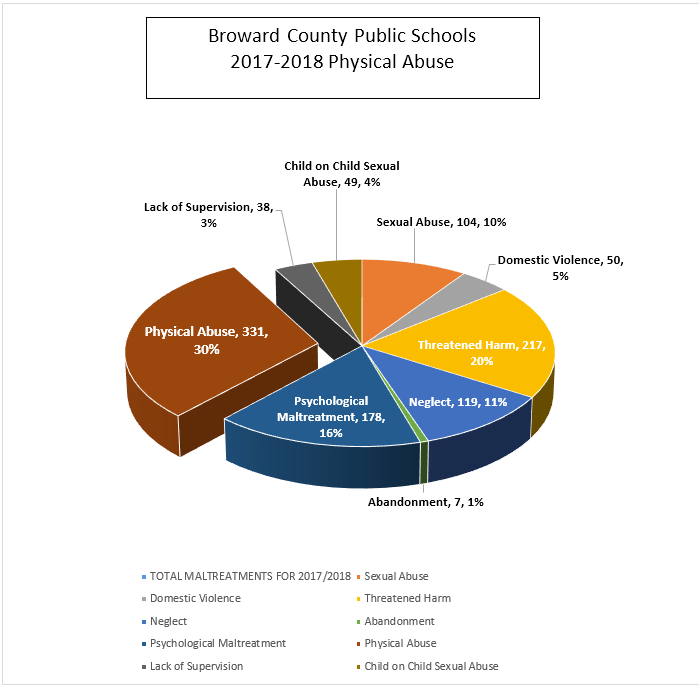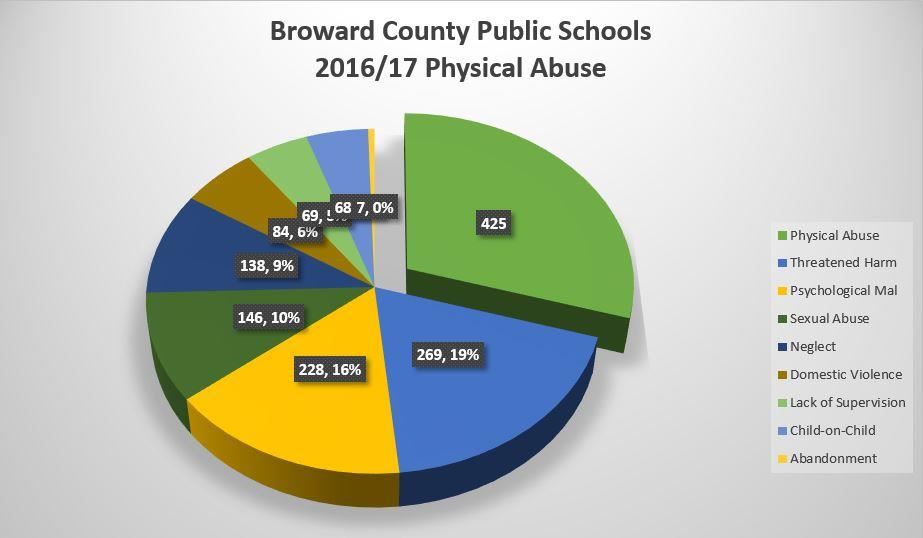Physical Abuse

Physical Abuse
-
Definition
As stated in Florida Statute 39, “abuse” means any willful act or threatened act that results in any physical, mental, or sexual injury or harm that causes or is likely to cause the child’s physical, mental, or emotional health to be significantly impaired. Abuse of a child includes acts or omissions. Corporal discipline of a child by a parent or legal custodian for disciplinary purposes does not in itself constitute abuse when it does not result in harm to the child.
Physical abuse involves injury that is inflicted upon a child and causes “harm” to the child’s health or welfare. Such injury includes, but is not limited to:
- Willful acts that produce the following specific injuries:
-
Sprains, dislocations, or cartilage damage
-
Bone or skull fractures
-
Brain or spinal cord damage
-
Intracranial hemorrhage or injury to other internal organs
-
Asphyxiation, suffocation, or drowning
-
Injury resulting from the use of a deadly weapon
-
Burns or scalding
-
Cuts, lacerations, punctures, or bites
-
Permanent or temporary disfigurement
-
Permanent or temporary loss or impairment of a body part or function.
“Willful” refers to the intent to perform an action, not to the intent to achieve a result or to cause an action.
-
- Inappropriate or excessively harsh disciplinary action that is likely to result in physical injury.
Corporal discipline may be considered excessive or abusive when it results in any of the injuries listed under (1) as well as significant bruises or welts.
In the context of determining willful physical injury or abusive corporal discipline, Florida Statute 39 requires consideration of the following factors in evaluating injury: the age of the child; any prior history of injuries to the child; the location of the injury on the body of the child; the multiplicity of the injury; and the type of trauma inflicted. This will be discussed further in the Indicators section.
Physical Abuse occurs when a physical injury is inflicted by a parent, or by another adult caregiver. Physical abuse may occur when a child is too harshly punished or when the punishment is not appropriate to the child’s age or condition. Physical indicators such as bruises or welts need not be present. Reports by the child, together with other behavioral indicators, may be all that is necessary to make a report to the Florida abuse hotline at: 1-800-96-ABUSE.
- Willful acts that produce the following specific injuries:
-
Indicators
School staff may observe physical or behavioral indicators of physical abuse. Some indicators reflect suspected injuries on a child’s body; some reflect reports or verbal statements made by the child or others; some reflect behaviors. The indicators below are a compilation from case examples in Broward County, the Child Abuse Prevention Sourcebook for Florida School Personnel, the federal Child Welfare Information Gateway, and from Cynthia Crosson Tower: The Role of Educators in Preventing and Responding to Child Abuse and Neglect, 2003.
Physical Indicators
- Bruises, welts, lacerations, or abrasions that are not explained in a logical or plausible manner (Note the student’s affect and body language when the explanation is not plausible. You may ask: “Did someone hurt you?”)
- Bruises or welts reflecting the shape of the article used to inflict an injury (extension cord, belt or belt buckle, hair brush, etc.)
- Slap marks on cheeks or around ears; pinch marks on upper arms; lash marks on back, upper thighs, or buttocks
- Burns- Circular in shape with blisters and ulcers, possibly caused be a cigarette or match tip
- Burns- Dry contact burns with shapes suggestive of irons, heating coils, hair dryer elements
- Scalding or immersion burns from setting the student into hot liquid or pouring it over the skin
- Burns of unknown origin
- Repeated patterns of injuries, even when logical explanations are given.
Indicators in children with disabilities
- Chronic bruising under the arms of non-ambulatory children or disabled adult students
- Pain or swelling in shoulder or wrist area
- Bruising around or in the mouth of children or disabled adult students who are not able to feed themselves.
Clues That May Indicate Abuse
- Asks for help by telling a friend, teacher, or other school staff about abuse
- Shows extremes in behavior, including self-destructive acts, aggression, or withdrawal
- Is aggressive, oppositional, or defiant
- Cowers or demonstrates fear of adults
- Shows fearlessness or extreme risk taking
- Seems agitated or anxious when other children are crying
- Afraid to go home or comes to school too early
- Student is noticeable wary of adult contacts
- Is destructive to self or others
- Is described as “accident prone”
- Wears clothing that covers the body and may be inappropriate in warm weather (be aware that this may be a cultural issue as well)
- Is unable to form good peer relationships
- Cheats, steals, or lies (may be related to too high expectations at home)
- Is a low achiever (to learn, children must convert aggressive energy into learning; children in conflict may not be able to do so)
- Shows regressive or less mature behavior
- Is frequently absent from school with unsubstantiated illnesses.
School employees should consider the location of injuries on a child’s body. Soft tissue injuries on the face thighs, backs of the arms, or injuries on the back, are more likely to have been inflicted than injuries to the bony areas of the body (knees, elbows, forearms). Also consider the child’s demeanor when telling about the injury. Does a child who normally talks very directly and comfortably with you now seem anxious, unable or unwilling to look at you?
-
Data
In the 2017-2018 school year, 30 percent of the reports made by Broward County Public Schools employees to the Florida abuse hotline involved suspected physical abuse. Very young children (under the age of 5) and adolescents are most at risk for physical abuse both here in Florida and in the nation.



School employees in Broward County report more suspected physical abuse than any other category of child maltreatment. We also report more physical abuse than many other areas of Florida. The most likely explanation for these differences involves our high level of cultural diversity and of student mobility.
-
Resources
The child abuse designee at your school, by School Board policy, is the person with whom you should communicate regarding abuse.
School nurses are good resource personnel for evaluating injuries when the explanation is not plausible. Nurses may offer a professional opinion concerning whether the injury appears to be accidental or inflicted. If there is a health center at your school, or your school has a health partnership, please use these resources when you are uncertain about physical abuse.
School resource officers are also excellent resources, as they have expertise in the areas of inflicted injuries and criminal law.
Serious or life-threatening injuries may require immediate medical attention. If a student comes to school with this type of injury, an administrator will call 911.
Outside agencies in the community will be utilized during child/adult protective investigations. The ChildProtection Team (CPT) may assist law enforcement and child protective investigators regarding children who have been reported to the abuse hotline. CPT provides a variety of services such as:
- Medical examinations
- Medical consultations (review of medical records)
- Psychosocial assessments
- Specialized interviews
- Forensic interviews of children
- Psychological evaluations
- Consultations
- Staffing (sharing of information among professionals involved in the case).
CPT may be reached at (954) 765-4159 for consultation.
Law enforcement agencies will determine whether the actions of parents/caregivers have broken the law.
The Broward Children’s Services Council (CSC), the Children’s Services Board (CSB) of Broward County, and the State of Florida provide funding for family strengthening programs. These programs provide in-home services to prevent abuse for high- risk families and to enable parents to provide the nurturance, structure, and appropriate discipline needed for optimal growth and development of children.
-
TO REPORT CHILD ABUSE, CALL 1-800-96ABUSE

